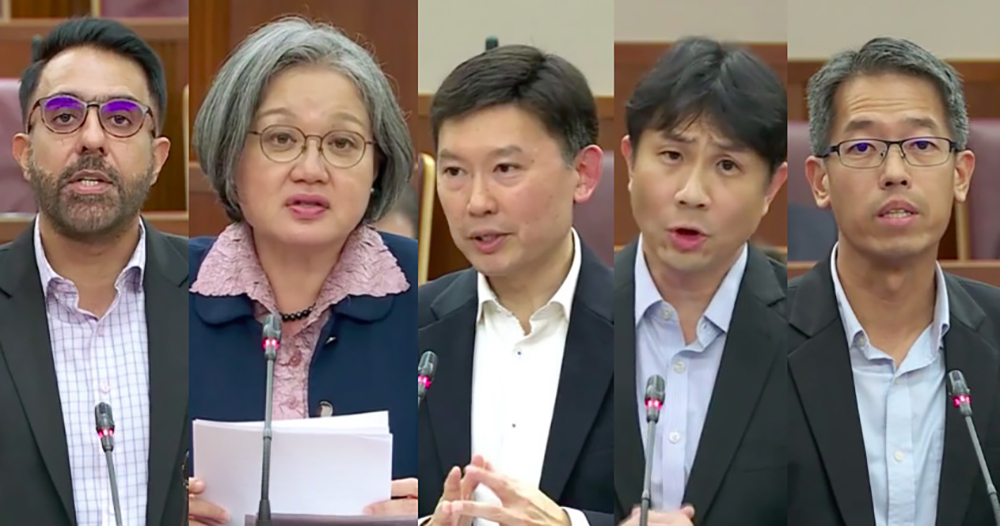On Nov. 7, 2023, the leader of the Workers' Party (WP), Pritam Singh, and one of its Members of Parliament (MP), Louis Chua, filed a motion to debate the cost of living in Parliament.
The debate saw 20 MPs speaking on how to help Singaporeans cope with the cost of living.
WP's suggestions included tweaks to the pricing structure of water and electricity and changes to the way the public transport and Certificate of Entitlement (COE) systems are operated.
Water and electricity prices
Singh: Five tiers for the price of water consumption
On the issue of utilities, Singh proposed that the current two-tier pricing system for water be restructured into five tiers to reflect the actual consumption of water better.
The five-tiered system will price water according to its consumption from 0-10, 10-20, 20-30, 30-40 and 40 and above cubic metres.
Under the current system, domestic water users pay more if they consume more than 40 cubic metres per month.
According to Singh, as of 2020, 96 per cent of households are consuming less than 40 cubic metres of water per month, with HDB flat-dwellers consuming about 16.2 cubic metres per month.
"Evidently, these HDB households in particular, are paying for water at the lower of the two tiers, but this supposedly lower tier captures users within a very wide pricing band of 0-40 cubic metres," he said.
In addition, the introduction of the five tiers should be done together with a Water Conservation Tax regime so that households which consume more cross-subsidise households which consume less.
Under this water price regime, the quantum of fiscal support provided through GST U-Save vouchers can be rightsized proportionately, he said.
Chee Hong Tat: Water in Singapore is priced to reflect its scarcity
In response to Singh's proposal, Senior Minister of State for Finance Chee Hong Tat said water in Singapore is priced to reflect its scarcity and to encourage its prudent and sustainable use.
He said introducing additional tiers would "distort households’ incentive to conserve water from the very first drop."
"It also means that the Government will have to subsidise everyone for water, not just the lower and middle-income, which is more costly and inefficient."
Chee explained that under the current two-tier system, the same rate is paid by everyone, from the very first drop used by the household, so that all users take into account the scarcity value of water.
"Or, if you have even more tiers, then, across different tiers, the water that is being consumed at the lower tiers will also include a subsidy to the wealthier families that consume more water," he added.
The government's approach is to, therefore, price water fully and then provide targeted and tiered support through U-Save rebates to those who need it the most.
Sylvia Lim: Tiered pricing for electricity consumption
WP MP Sylvia Lim also suggested tiered pricing for electricity consumption.
Under such a system, households that consume electricity below a certain threshold will be charged at a lower rate, while those consuming higher amounts will pay higher rates for the excess consumption.
Sylvia Lim also put forth a suggestion to charge lower rates for non-peak hours.
She pointed out that a key driver of the costs of producing electricity is not the total load but the peak hour load.
"Having a cheaper rate for off-peak consumption would benefit the system as a whole, as it will go towards ensuring that the peak demand can be more efficiently met by the existing transmission grid," Sylvia Lim explained.
Chee: Government is already exploring electricity pricing based on time
In response, Chee said the rationale behind the pricing of water also applies to electricity.
He added that Lim's idea of pricing electricity based on time is something that the government agrees with and has already announced an initiative on the matter.
"This is an accurate reflection of the actual cost of producing electricity during different periods of the day," he said.
Transport and COE
Jamus Lim: Transfer excess quotas from high-supply years to low-supply ones
About the COE system, WP MP Jamus Lim suggested smoothening the vehicle quota supply by transferring excess quotas from high-supply years to low-supply ones.
He also proposed dropping the Open category and making people pay exactly for what one bid for instead of the lowest successful bid.
On his suggestion of transferring excess quotes, Jamus Lim noted that the government currently borrows from the future supply of COEs that will come from the deregistration of vehicles, a process which he described as "marginal transfers".
This approach discourages owners from deregistering their vehicles in low-supply years because they will have to purchase new COEs at high prevailing prices and incentivises them to sell their cars in high-supply years and get reimbursed for their COEs.
Both of these practices have also contributed to the supply gap.
Jamus Lim then proposed ending the practice of reimbursing people at book value for COEs that are deregistered early.
Chee: Jamus Lim agrees with the government about smoothening the supply of COE
Here, Chee replied that Jamus Lim agreed with the government about smoothening the supply of COE.
Currently, the government has announced an increase in the COE quota for the coming quarter, with a 35 per cent increase for both Categories A and B and a 65 per cent increase for Category C.
However, the government should also be cautious of the impact of overdoing the increase, as the government is effectively borrowing from the future, from cars still on the road.
Overdoing it could result in more cars on the road, leading to congestion, he said.
Gerald Giam: Set up a National Transport Corporation
WP MP Gerald Giam proposed establishing a National Transport Corporation (NTC) to oversee the planning and operation of all MRT, LRT and trunk bus services in Singapore.
He noted that the rate of increase in bus and train fares has been faster than that of core inflation over the past 10 years.
Under his proposed model, "substantial" profits which go to the public transport operators and their shareholders could instead be redirected to the benefit of commuters.
With full access to the NTC's financial records, he said the government could set fares high enough to ensure the NTC's fiscal sustainability without overly burdening commuters.
Chee: Removing the profit element does not guarantee better outcomes for commuters
Chee replied that nationalising and removing the profit element is not an assurance or guarantee that outcomes for commuters will be better.
He explained that for trains, the operators do collect fares to cover their operating costs.
Chee said that SBS Transit also reported a loss of several million dollars for their rail operations for the latest financial year, while SMRT Trains reported an operating profit of S$6 million, which represents a profit margin of less than 1 per cent.
As for buses, the revenue that is collected does not go to the operators.
Instead, it goes to the government, who then pays the operators under a rate that was agreed through the bus contracting tenders.
Chee added:
"We will continue to monitor the need for more targeted support if inflation or economic outlook worsens.
We will do so while maintaining discipline in ensuring that our interventions are fair, sustainable, and effective."
All screenshots via CNA

If you like what you read, follow us on Facebook, Instagram, Twitter and Telegram to get the latest updates.



